Vad är en regnskog?
En skog som kallas regnskog måste ständigt vara grön. Det måste regna minst 2000 mm (alltså 2 meter) per år. Det är fyra gånger så mycket regn som det faller i Skåne på ett år! För att det ska räknas som en regnskog måste det regna regelbundet under 9 månader per år. Det finns platser i regnskogen där det regnar 8500 mm på ett år!
Regnskogarna kallas ofta för jordens lungor, eftersom de tillverkar en stor del av syret i vår atmosfär, och renar luften. Vattnet som sugs upp genom rotsystemen renas, och skogen lagrar enorma mängder koldioxid när den växer.
För att en skog ska kallas för regnskog måste det falla minst 2 meter regn per år över skogen.
Bild: Andreas-Tollkotter-CC-BY-SA
Krontaket över en regnskog i Australien.
Bild: CSIRO-CC-BY
Krontaket i en regnskog blir ofta så tätt, att tillgången på ljus blir väldigt liten på marken. Konkurrensen om ljus är väldigt stor i regnskogen.
Bild: Jaygayani-CC-BY-SA
Tak av trädkronor
I regnskogen växer träden så tätt att trädkronorna bildar ett så kallat krontak. På marken växer mycket lite, eftersom krontaket stoppar solljuset från att nå ner. Så fort ett träd faller i regnskogen, är det många olika växter som slåss om ljuset som blir tillgängligt. Träden växer snabbt på höjden, för att först komma åt det dyrbara ljuset. Mellan den mörka marken och krontaket finns ett skikt där löven är som störst, och det största antalet insektsarter lever.
Ungefär hälften av jordens alla djur- och växtarter lever i regnskogen. Alla delar av en regnskog myllrar av liv, och alla ytor används av någon eller något.
Växten bromelia trivs i regnskogen, och växer i grenklykor på träd. I bladrosetten på bromelior trivs små grodor.
Bild: Geoff-Gallice-CC-BY
Ceylondjungelhönan - en släkting till de höns vi föder upp för kött och ägg, lever i regnskogen. Det gör också tamhönsens förfäder.
Bild: Asif-N-Khan-CC-BY-SA
Skogselefanten lever i regnskogsområden i Kongo.
Bild: dsg-photo.com-CC-BY-SA
Den ovanliga fågeln hjälmvanga lever i Madagaskars regnskogar.
Bild: Eric-Mathieu-CC-BY-SA
Den utrotningshotade orangutangen är beroende av regnskogen i Indonesien.
Bild: RaiyaniM-CC-BY-SA
Överallt i regnskogen lever insekter, både små och stora. Som den här drakhuvudinsekten i Costa Rica.
Bild: Geoff-Gallice-CC-BY
Den tvåtåiga sengångaren lever också i Costa Ricas regnskog.
Bild: Geoff-Gallice-CC-BY
Vi människor använder dagligen produkter som kommer från regnskogen, som frukter, kaffe, choklad, virke, smink och olika oljor.
Bild: John-Ocampo-CC-BY-SA
Hundra arter i ett enda träd
Regnskogar har funnits i ca 60 miljoner år. Hälften av alla djur- och växtarter – ungefär 4,5 miljoner – lever i regnskogarna. I ett enda träd kan det finns runt 100 arter av allt från däggdjur till ryggradslösa djur. Många däggdjur, reptiler, groddjur, fåglar, insekter, växtarter och svampar lever bara i regnskog.
Varje dag använder människor produkter som har sitt ursprung i regnskogarna. Det kan vara inomhusväxter, parfymer, tuggummi, virke, möbler, gummi, kaffe, kakao, avokado, nötter, kokosnötter, mango, bananer, ananas, apelsin, tobak, smink och olika vegetabiliska oljor. En stor del av råmaterialet till mediciner kommer också från regnskogen.
Stora tropiska regnskogar, som Amazonas, kan skapa sitt eget väder. När mycket vatten avdunstar under förmiddagarna, skapas moln över skogen på eftermiddagarna, som sedan regnar tillbaka ned på skogen. Vattnets kretslopp är mycket snabbt i regnskogen.
Molnskog kallas en typ av regnskog på hög höjd. De har en kallare medeltemperatur än den omgivande regnskogen på lägre höjd. I molnskogar ligger ofta molntäcket i höjd med krontaket.
Bild: Ade-javanese-CC-BY-SA
Tempererade regnskogar finns längre från ekvatorn än tropiska regnskogar. De ligger i kustområden som till exempel Chile, södra Australien, Nordamerikas nordvästkust som Oregon på bilden, och faktiskt även Norge!
Bild: Sam-Beebe-CC-BY
Tropiska regnskogar – och regnskog i Norge!
Regnskogar finns i flera klimat, både tropisk regnskog, subtropisk regnskog och tempererad regnskog. Tropisk regnskog finns bara i tropikerna. Tropikerna är namnet på ett brett bälte runt ekvatorn – Centralamerika, Sydamerika, Sydostasien och Centralafrika. Vattnets kretslopp är snabbt i tropiska regnskogar. Stora mängder vatten avdunstar under förmiddagarna, för att sedan regna ner på eftermiddagarna. Medeltemperaturen i regnskogen är 27°C. Det finns inga årstider som i Sverige, det enda som varierar är mängden regn.
Subtropisk regnskog finns mest på asiatiska kontinenten. Klimatet växlar i subtropisk regnskog, mellan längre, varma, regnperioder och kortare, kallare, torrperioder. Tempererad regnskog finns i områden med fuktiga västvindar som Nordamerikas nordvästra kust, i Alaska, södra Chile, delar av Australien och Nya Zeeland och även i norra Spanien – och faktiskt en liten del av Norge.

Ögonfranshuggorm
Bothriechis schlegelii
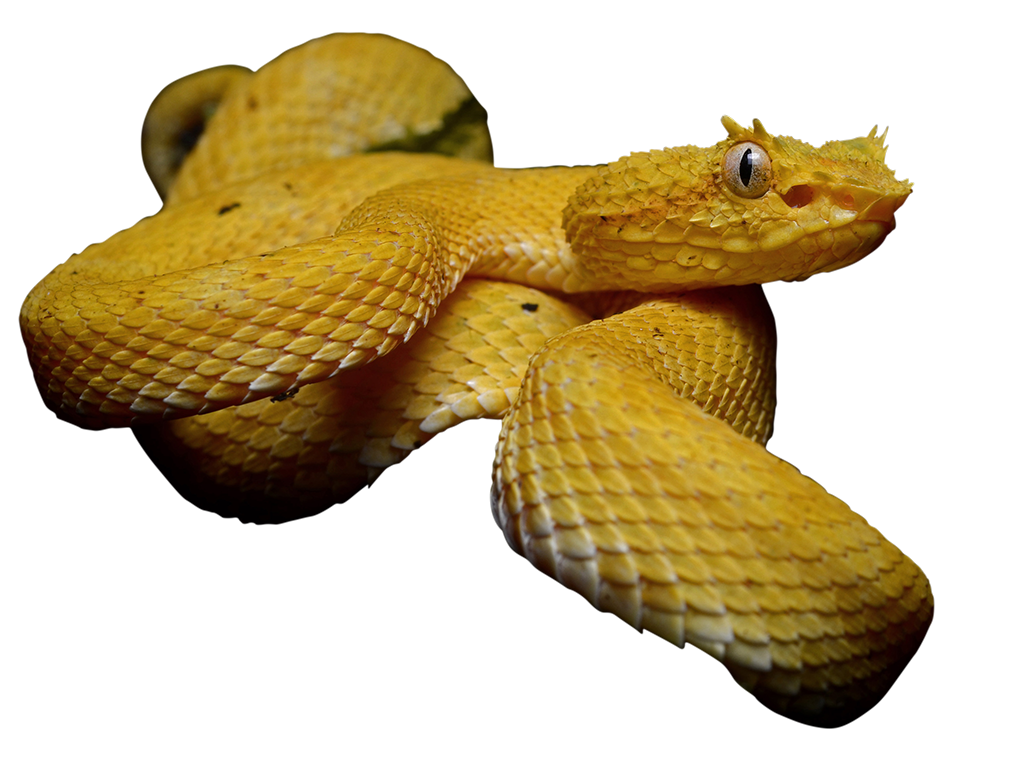
Lurar sina byten med svanstippen
Ögonfranshuggormen vickar på sin svans för att locka till sig bytet när den jagar. Då liknar svansen en mask eller larv. När bytet kommer hugger ormen extremt snabbt. Giftet kan vara dödligt för människor men de flesta som får sjukvård överlever. Ögonfranshuggormen äter och sover i träden.
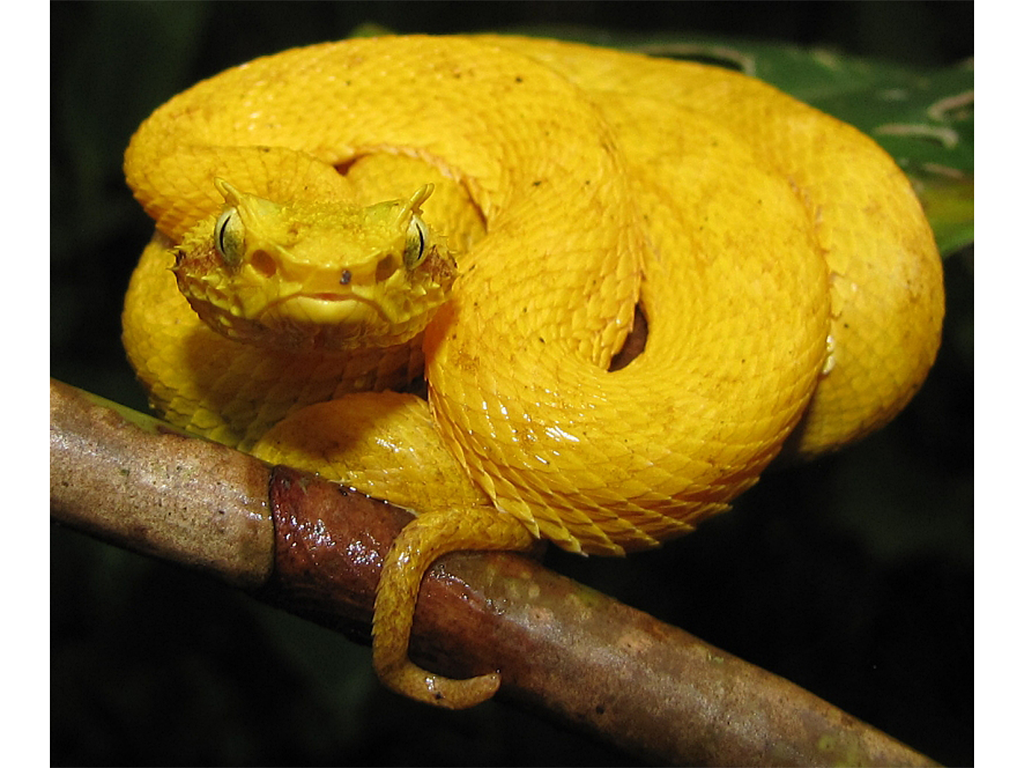
Bild: Sdbeazley-CC-BY
Föder levande ungar
Titta noga så ser du att ormen har utstickande fjäll ovanför ögonen. Fjällen ser ut som ögonfransar och därför kallas ormen ögonfranshuggorm. De finns i många färger som röd, gul, grön, brun och till och med rosa.
Honan bär äggen i sex månader. Äggen kläcks inne i honan. När de 2–20 små ormarna utvecklats klart i honan föds de. Då är de ca 15–20 cm långa.
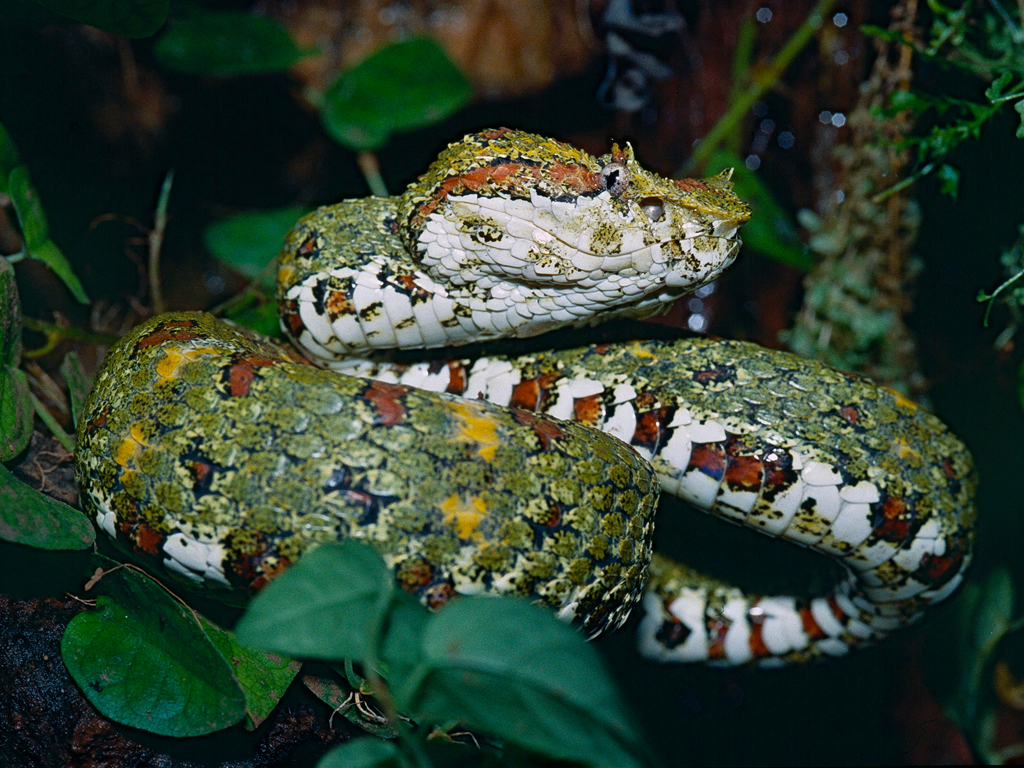
Bild: Bernard-DUPONT-CC-BY-NC-SA
Utbredningsområde i världen
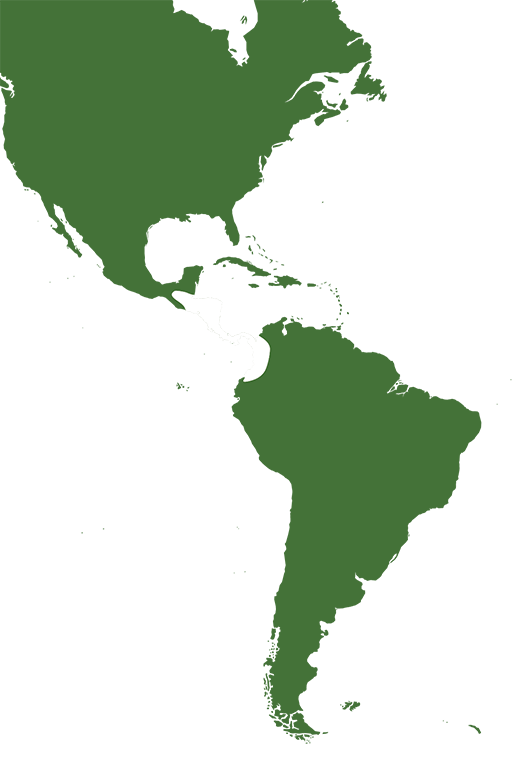
Central- och Sydamerika.
Hotstatus enligt Rödlistan

Reglerad inom handel
CITES: Ej listad.

Vad är Rödlistan?
Rödlistning är ett sätt att bedöma om olika djur- och växtarter är utrotningshotade utifrån kriterier som hur många djur eller växter som finns av arten och hur utbredda de är. En nationell rödlistning bedömer artens risk att dö ut inom ett lands gränser. Den internationella rödlistningen bedömer artens risk att dö ut över hela jorden.
Läs mer

Om rödlistning i Sverige: Artdatabanken, www.artdatabanken.se
Om rödlistning i världen: International Union for Conservation of Nature, IUCN, www.iucn.org

Vad är CITES?
För att bekämpa olaglig handel med djur och växter finns en internationell överenskommelse om handel, som heter CITES. CITES innebär att utrotningshotade djur och växter inte får köpas eller säljas mellan olika länder utan tillstånd.
CITES klassar olika arter i olika kategorier (som kallas Appendix I, II och III) beroende på hur hotad arten är. Ju större hotet från handeln är desto högre skydd. Inom EU finns ytterligare skydd för arter i CITES. EU:s egen klassning har fyra steg: A-D.
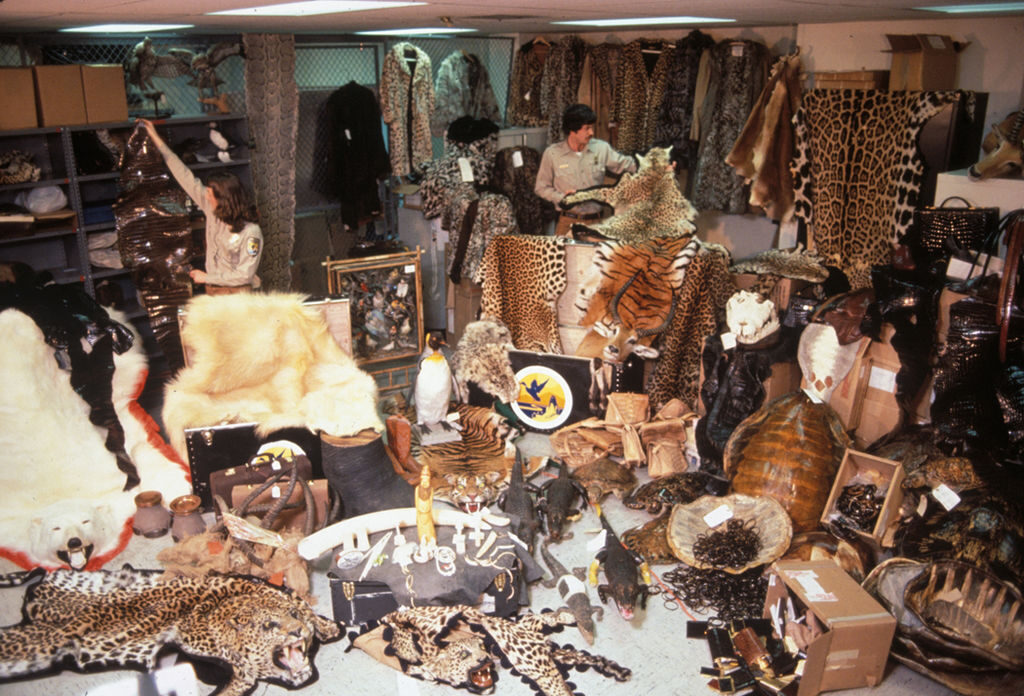
Bild: Steve-Hillebrand
Förbjudet att handla med viltfångade arter
Högst skydd mot handel har de arter som är inom kategori A och B. Här gäller oftast att handel mellan EU och övriga världen är förbjuden utan tillstånd. Arter som är CITES A eller B-klassade får inte heller köpas eller säljas inom EU om det inte kan bevisas att de har lagligt ursprung och inte fångats i det vilda.
Att använda växter eller djur för att tillverka souvenirer och annat är också förbjudet. Den som bryter mot reglerna kan dömas till böter eller fängelse.
Kontrollera spridning av arter
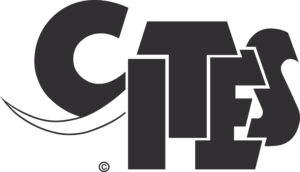
Arter som är CITES C-klassade är utrotningshotade i ett visst land men inte nödvändigtvis i hela världen. CITES D-klassning betyder att en art importeras i så stort antal att de behöver regleras för att inte riskera att sprida sig okontrollerat där de inte hör hemma.

What is a rainforest?
A forest called a rainforest must be permanently green. It must get at least 2,000 mm (2 metres) of rain per year. That is four times as much rain as Skåne gets in a year! For it to count as a rainforest, it must rain regularly for 9 months of the year. There are places in the rainforest that get 8,500 mm of rainfall in a year!
Rainforests are often called the lungs of the earth, because they produce much of the oxygen in our atmosphere, and clean the air. The water sucked up by the root systems is purified, and the forest stores huge amounts of carbon dioxide as it grows.
For a forest to be called a rainforest, it must get at least 2 meters of rain per year.
Photo: Andreas-Tollkotter-CC-BY-SA
The canopy of a rainforest in Australia.
Photo: CSIRO-CC-BY
The canopy in a rainforest is often so dense that the supply of light is very low on the ground. The competition for light is very big in the rainforest.
Photo: Jaygayani-CC-BY-SA
Roof of tree tops
In the rainforest, trees grow so densely that the tops form what is known as a canopy. Very little grows on the ground, as the canopy stops sunlight from reaching that far down. As soon as a tree falls in the rainforest, many different plants compete for the light that becomes available. The trees grow rapidly in height, trying to be the first to access the precious light. Between the dark ground and the canopy, there is a layer where the leaves are at their largest, and the greatest number of insect species live.
About half of the earth's animal and plant species live in the rainforest. All parts of a rainforest are full of life, and all surfaces are used by someone or something.
The plant bromeliad thrives in the rainforest, and grows on tree branches. In the middle of bromeliad plants is a small puddle of water, where small frogs thrive.
Photo: Geoff-Gallice-CC-BY
The Sri Lankan junglefowl - a relative of the hens we raise for meat and eggs - lives in the rainforest. So do the ancestors of domestic chickens.
Photo: Asif-N-Khan-CC-BY-SA
The African forest elephant lives in the Congolian rainforest.
Photo: dsg-photo.com-CC-BY-SA
The helmet vanga, a rare bird that lives in the rainforests of Madagascar.
Photo: Eric-Mathieu-CC-BY-SA
The endangered orangutan depends greatly of the Indonesian rainforests.
Photo: RaiyaniM-CC-BY-SA
Insects, both small and large, live everywhere in the rainforest. Like this dragon-headed bug in Costa Rica.
Photo: Geoff-Gallice-CC-BY
The two-toed sloth also lives in the rainforest of Costa Rica.
Photo: Geoff-Gallice-CC-BY
Us humans use products that come from the rainforest on a daily basis, such as fruit, coffee, chocolate, wood, make-up and various oils.
Photo: John-Ocampo-CC-BY-SA
A hundred species in a single tree
Rainforests have existed for about 60 million years. Half of all animal and plant species – about 4.5 million – live in rainforests. A single tree can contain around 100 species of everything from mammals to invertebrates. Many mammals, reptiles, amphibians, birds, insects, plant species and fungi live only in rainforests.
Every day, people use products that originated in the rainforests. These include houseplants, perfumes, chewing gum, wood, furniture, rubber, coffee, cocoa, avocados, nuts, coconuts, mangoes, bananas, pineapples, oranges, tobacco, make-up and various vegetable oils. Much of the raw material for medicines also comes from the rainforest.
Large tropical rainforests, such as the Amazon, can create their own weather. When a lot of water evaporates in the mornings, clouds form over the forest in the afternoons which then causes the rain to fall on the forest again. The water cycle is very fast in the rainforest.
Cloud forest is the name of a type of rainforest at high altitude. They have a colder average temperature than the surrounding rainforest at lower altitudes. In cloud forests, the cloud cover is often at the height of the canopy.
Photo: Ade-javanese-CC-BY-SA
Temperate rainforests are further from the equator than tropical rainforests. They are located in coastal areas such as Chile, southern Australia, the northwest coast of North America such as Oregon in the picture, and in fact even Norway!
Photo: Sam-Beebe-CC-BY
Tropical rainforests – and rainforests in Norway!
Rainforests are found in several climates, from tropical and subtropical to temperate parts of the world. Tropical rainforests are only found in the tropics. The tropics is the name of a wide belt around the equator, taking in Central America, South America, Southeast Asia and Central Africa. The water cycle is fast in tropical rainforests. Large amounts of water evaporate in the mornings, and then rain down in the afternoons. The average temperature in the rainforest is 27°C. There are no seasons like in Sweden, the only thing that varies is the amount of rain.
Subtropical rainforests are found mostly on the Asian continent. The climate alternates in the subtropical rainforest between long, hot, rainy periods and shorter, colder, dry periods. Temperate rainforests are found in areas with moist westerly winds such as the northwest coast of North America, Alaska, southern Chile, parts of Australia and New Zealand, and even northern Spain – and actually a small part of Norway.

Eyelash Viper
Bothriechis schlegelii

Tricks its prey by wiggling its tail
When it hunts, the eyelash viper wiggles its tail to attract prey. Then the tail looks like a worm or larva. When the prey comes, the viper strikes very quickly. The venom can be poisonous to humans but most people who receive medical attention survive. The eyelash viper eats and sleeps in trees.

Photo: Sdbeazley-CC-BY
Gives birth to live young
Look carefully and you will see that this snake has scales that stick out over its eyes. The scales look like eyelashes and that is why the snake is called the eyelash viper. Eyelash vipers come in many colours, including red, yellow, green, brown, and even pink.
The female carries eggs for six months. The eggs hatch inside her. When the small snakes, numbering from 2 to 20, have finished developing inside her, they are born. Then they are about 15 to 20 centimetres long.

Photo: Bernard-DUPONT-CC-BY-NC-SA
Distribution worldwide

Central and South America.
Threat based on the Red List

Trade regulations
CITES: Not listed.

What is the Red List?
The Red List is a way to assess whether different animal and plant species are at risk of extinction based on criteria such as how many animals or plants of a species exist and how widely distributed they are. A national Red List assesses a species’ risk of dying out within national borders. The international Red List assesses a species’ risk of dying out worldwide.
Read more

About the Red List in Sweden: The Swedish Species Information Centre (Artdatabanken), www.artdatabanken.se/en/
About the Red List worldwide: The International Union for Conservation of Nature (IUCN), www.iucn.org

What is CITES?
CITES (the Convention on International Trade in Endangered Species of Wild Fauna and Flora) is a treaty that makes it illegal to buy or sell animals and plants that are at risk of extinction between countries without a permit.
CITES classifies species into different categories (called Appendix I, II and III) depending on how endangered each species is. In addition, the more the species is threatened by international trade, the higher its level of protection. Within the EU, CITES-listed species are further classified and protected by the EU’s own classification system. This has four Annexes, from A to D.

Photo: Steve-Hillebrand
Ban on trading wild-caught species
The highest protection against trade is given to CITES-listed species included in the EU’s Annexes A and B. Usually this means that trade between the EU and the rest of the world is illegal without a permit. There is also a ban on trading these species within the EU unless it can be proved that they have a lawful origin and were not caught in the wild.
It is also forbidden to use plants or animals to make souvenirs etc. Anyone who breaks these regulations can be fined or imprisoned.
Controlling the spread of species

CITES-listed species that are in the EU’s Annex C are classified as endangered in at least one country but not necessarily in the whole world. An Annex D classification means that individual members of a species may be imported to the extent that they do not need to be regulated to avoid any risk of them spreading uncontrollably where they do not belong.
